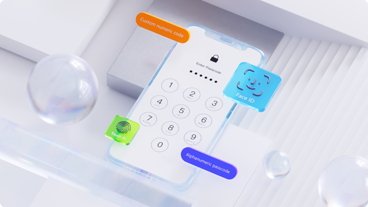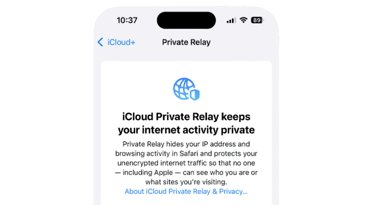Apple says iPhone 4 calculates bars wrong, software fix forthcoming
The letter confirms what two in-depth takes released this week had already stated: that there is a flaw in how Apple's iOS mobile operating system reports bars of signal strength.
Apple's iOS allots nearly 40 percent of reception levels to five bars, from -51 dB to -91 dB. But the distance from four bars to one bar of reception is much less, from -91 dB to -113 dB.
"Our formula, in many instances, mistakenly displays 2 more bars than it should for a given signal strength," Apple's letter reads. "For example, we sometimes display 4 bars when we should be displaying as few as 2 bars. Users observing a drop of several bars when they grip their iPhone in a certain way are most likely in an area with very weak signal strength, but they don't know it because we are erroneously displaying 4 or 5 bars."
A software fix due to be released in the coming weeks will adopt AT&T's guidelines for signal strength reporting, which will result in a more accurate portrayal of reception on the iPhone 4.
"We have gone back to our labs and retested everything, and the results are the same— the iPhone 4's wireless performance is the best we have ever shipped," the letter states. "For the vast majority of users who have not been troubled by this issue, this software update will only make your bars more accurate. For those who have had concerns, we apologize for any anxiety we may have caused."
Testing of the iPhone 4 found that holding it in the left hand and covering the left side of the device can reduce reception by 24 dB. For a user with a "weak," incorrectly reported five bars, this can result in a dramatic reduction of bars on the iPhone 4.
Apple's software update plans to correct this issue, and more accurately report the signal degradation from holding the device — something the company said occurs with any phone, including the iPhone 3GS, and phones from competitors like Nokia, Research in Motion, and those running Google's Android mobile operating system.
Included is Apple's letter in its entirety:
Dear iPhone 4 Users,
The iPhone 4 has been the most successful product launch in Apple's history. It has been judged by reviewers around the world to be the best smartphone ever, and users have told us that they love it. So we were surprised when we read reports of reception problems, and we immediately began investigating them. Here is what we have learned.
To start with, gripping almost any mobile phone in certain ways will reduce its reception by 1 or more bars. This is true of iPhone 4, iPhone 3GS, as well as many Droid, Nokia and RIM phones. But some users have reported that iPhone 4 can drop 4 or 5 bars when tightly held in a way which covers the black strip in the lower left corner of the metal band. This is a far bigger drop than normal, and as a result some have accused the iPhone 4 of having a faulty antenna design.
At the same time, we continue to read articles and receive hundreds of emails from users saying that iPhone 4 reception is better than the iPhone 3GS. They are delighted. This matches our own experience and testing. What can explain all of this?
We have discovered the cause of this dramatic drop in bars, and it is both simple and surprising.
Upon investigation, we were stunned to find that the formula we use to calculate how many bars of signal strength to display is totally wrong. Our formula, in many instances, mistakenly displays 2 more bars than it should for a given signal strength. For example, we sometimes display 4 bars when we should be displaying as few as 2 bars. Users observing a drop of several bars when they grip their iPhone in a certain way are most likely in an area with very weak signal strength, but they don't know it because we are erroneously displaying 4 or 5 bars. Their big drop in bars is because their high bars were never real in the first place.
To fix this, we are adopting AT&T's recently recommended formula for calculating how many bars to display for a given signal strength. The real signal strength remains the same, but the iPhone's bars will report it far more accurately, providing users a much better indication of the reception they will get in a given area. We are also making bars 1, 2 and 3 a bit taller so they will be easier to see.
We will issue a free software update within a few weeks that incorporates the corrected formula. Since this mistake has been present since the original iPhone, this software update will also be available for the iPhone 3GS and iPhone 3G.
We have gone back to our labs and retested everything, and the results are the same— the iPhone 4's wireless performance is the best we have ever shipped. For the vast majority of users who have not been troubled by this issue, this software update will only make your bars more accurate. For those who have had concerns, we apologize for any anxiety we may have caused.
As a reminder, if you are not fully satisfied, you can return your undamaged iPhone to any Apple Retail Store or the online Apple Store within 30 days of purchase for a full refund.
We hope you love the iPhone 4 as much as we do.
Thank you for your patience and support.
Apple
 AppleInsider Staff
AppleInsider Staff













 Amber Neely
Amber Neely
 Thomas Sibilly
Thomas Sibilly

 William Gallagher
William Gallagher
 Malcolm Owen
Malcolm Owen
 Christine McKee
Christine McKee










435 Comments
So no more dropped calls?
This is exactly what I suspected all along but I expect those screaming it is a major issue to claim this is an excuse. All reports show the iPhone 4 has better signal capture than the 3Gs so the issues with the bars is obviously letting users venture into weaker signal areas, add in a falsely high bar reading then add in a hand over the antennae and voila ... the hysteria!
I'm sure there will be plenty of people who will complain about this too!
"As a reminder, if you are not fully satisfied, you can return your undamaged iPhone to any Apple Retail Store or the online Apple Store within 30 days of purchase for a full refund."So there you go. Shut up or take it back.
So no more dropped calls?
If, with the corrected signal bar reading, you move to an area of good signal then assuming the other end or tower has no issues then it should stop most drops. The issue now is users are being lulled into thinking they have a good signal when they don't. At that point blocking the signal is pretty easy whereas in a stronger signal area the blocking won't occur to the extent it drops a call.